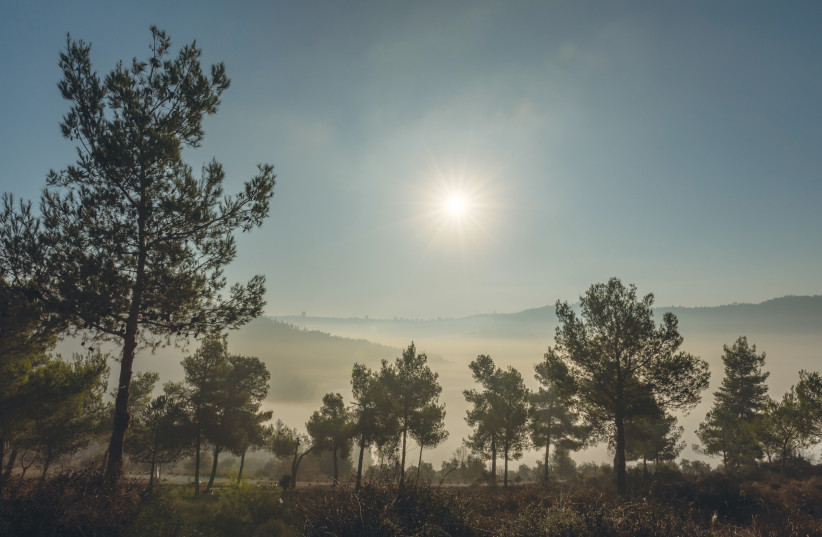Many Jerusalem trees are in danger, such as the ones in the Valley of Olives in the East Talpiot neighborhood being felled by greedy wood traders.
Too many trees are cut down, too many trees are uprooted without taking into account their chance to survive a transfer, too many questions remain unanswered regarding who is cutting trees and what profits are being made when felled trees end up in factories where they are sliced, processed and sold.
“Somebody makes money from these sacrificed trees. A tracking of this trail should be done in order to find out who is behind this. We alone cannot do that; we are already mobilized to run from place to place to stop illegal tree harvesting, to submit appeals to the Court in cases where we fail to stop the process, and to fight against city administrations that fail to protect our natural legacy,” said an activist who asked not to be identified.
“IT WAS Simhat Torah,” recalls Ilana Sirkiss, “and out of nowhere came three men in a van, with axes, who began to cut down trees. Three trees were already sacrificed before a neighborhood resident saw them from her balcony, alerted the police and succeeded to stop these men from continuing with their destructive mission.”
Photos of the cutters, the cut-down trees and the van were immediately uploaded on the Facebook account of the activists, stirring a lot of emotion. But Sirkiss says these things happen almost every day – not always spotted or stopped in time.
“On one of the hottest days this summer, on Tisha Be’Av, there was another such case. I called all the officials at Safra Square, including city council members, haredim and religious – but it was Tisha Be’Av – no one answered and we couldn’t stop the tree destruction.”
Such vigilance has become the daily duty of residents who care about trees in this city and are dedicated to prevent the wanton destruction. Some say it is a lost battle but they won’t stop fighting.
“We all know the state of our planet and the climate crisis befalling us. Trees are the best way to preserve the planet and contribute to improving of the climate. How does that work with cutting them down?” asks Sirkiss.
TO WHAT degree are the trees of Jerusalem really endangered? Who is in charge of protecting them and what does the law say on that matter?
National forest officials are responsible at the national level but each city has its own forest officials – municipal employees. Hence, points out Sirkiss, a local forest official is unable to counter the city council or the mayor’s decision – for example, in Rehes Lavan, where the approved construction plan will cause some 11,000 mature trees to be uprooted. It is unclear whether they will be replanted and where. Not to mention, she adds, not all trees survive uprooting and replanting.

During 2019 some 6,660 trees were cut down. It is unknown what the policy of the municipality is regarding cutting down of trees during the shmita year, but Sirkiss and her fellows activists plan to mobilize the haredi/religious representatives at the City Council to enlarge the concept of shmita and stop cutting for the year.
But there is more. According to the expansion plan of the new American Embassy, more than 300 mature trees will be felled. Another 500 trees are slated to be removed to enlarge the Knesset. Thousands of additional trees are imperiled by other construction plans across the city.
Nature activists say that there is no comprehensive plan for the protection of old trees. In most cases the only care given to an old tree is pruning. There is almost no budget for complex treatments for fertilization, protection from pests and disease, and orthopedic treatments (branch and trunk support). Sometimes old trees deteriorate even before it is decided to cut them down.
BY LAW, residents do not have the right to cut down a tree, even in a private garden. A request for a permit to cut down a tree has to be submitted to the municipal forest official at the before any action is taken. However, according the official registration in the City Improvement Department (to which the forest official belongs) the majority of these requests are approved. The unidentified activist feels that too many requests are approved, and nobody knows what is done with the trees cut down.
“They are cut down, taken and sold. Who profits and how much? No one knows.”
One small achievement was that the municipality adopted a plan for mapping empty tree holes in order to plant new trees in them. The municipality and the Society for the Protection of Nature put up a website where residents can indicate the location of an empty hole and upload a photo so the municipality can fill it with a young seedling.
“Better than nothing, but the problem is still the cutting down,” said the activist.
A spokesman for the municipality responded as follows:
“It is estimated that there are about 150,000 trees in the city in the public areas. It should be noted that a survey of trees is currently being conducted in order to get a complete picture of their exact number in the city. Also, any felling of a tree, whether in a private area or in a public area, requires the prior approval of the forest official as well as the provision of scenic compensation by performing the work at a monetary value of the felled trees and with the approval of the forest official. Felling trees without this permit exposes the offender to enforcement proceedings, which include, among other things, filing of an indictment.”
“Trees in Jerusalem are not just an academic or public issue. Old trees have historical, cultural and scenic value,” adds Sustainable Jerusalem lobby chairman Naomi Tzur.
